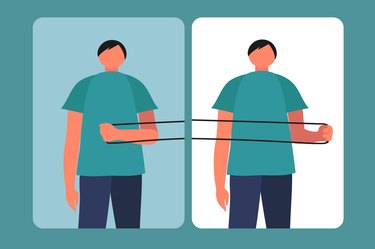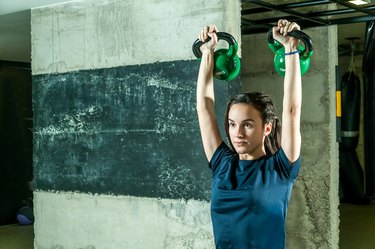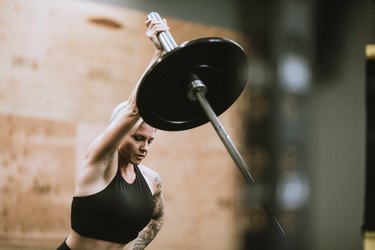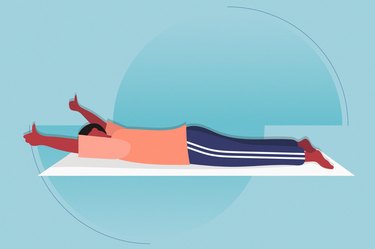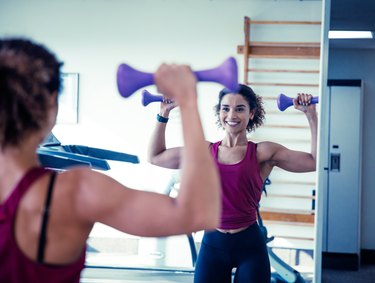

Overhead shoulder presses are probably one of the most popular upper-body exercises you see in the gym. And for good reason: They build great upper-body strength, muscle and stability. But they're also among the most risky moves to perform if you don't have your form on lock.
- What is a shoulder press? It's an exercise that involves pressing a weight straight over your head.
- What are the main shoulder press muscles worked? This move mainly targets the three parts (or heads) of your shoulders, including your anterior (front) delt, lateral (side) delt and posterior (rear) delt. But you also get involvement of your deep core muscles, the muscles in your upper back, pecs and triceps, too.
- Who can do a shoulder press? This move demands a lot of mobility from your shoulders. If you feel any discomfort with this move, it's probably best to skip it. And anyone with previous shoulder injuries should talk with a physical therapist or doctor before giving it a go.
Video of the Day
Related Reading
How to Do a Dumbbell Shoulder Press With Perfect Form
Dumbbell Shoulder Press
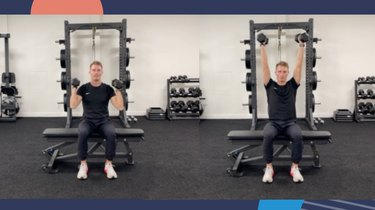
- Sit on a bench with your feet rooted in the ground, holding a dumbbell in each hand.
- Hold the weights to your sides with your forearms vertical, hands in a neutral grip with fingers toward your face. Your arms shoulder be just slightly in front of your body. Brace your core.
- On an exhale, press both dumbbells up and in toward each other.
- Lower the weights back to the starting position with control.
Watch the Full Overhead Press Tutorial
Tip
For a more supported spine, place your back against the bench's back rest. This can reduce how hard your core has to work and lets you really isolate your shoulders.
5 Tips for Better Overhead Presses
1. Keep Your Shoulder Blades Back and Down
It's common for people to scrunch up their shoulders as they raise the weights. But doing so can add stress on your neck and minimize a lot of the strength-building benefits of the exercise. After all, when you scrunch up, it means you're focusing on your upper traps, rather than your shoulders.
As you set up for your overhead press, imagine pulling your shoulder blades back away from your ears and down, says New York-based certified personal trainer Carolina Araujo, CPT. Maintain this position throughout the entire exercise.
2. Use the Grip That Feels Best
There are a few ways you can hold your dumbbells during this exercise, according to Brad Whitley, DPT, a California-based physical therapist.
For beginners, holding the dumbbells with your fingers facing your face (aka a neutral grip) probably feels most comfortable. But you can also hold the weights at an angle with your fingers halfway between a neutral and pronated grip (fingers facing away from you). For many people, this angle feels easier on the shoulders. Sometimes, people start the bottom of each rep with a pronated grip and end overhead with a neutral grip.
Lastly, another popular grip you see for this move is the full pronated grip, which is another option to consider. This places the most emphasis on the lateral delts.
Your best bet is to test all three and see which feels most comfortable throughout the entire motion.
3. Brace Your Core and Tilt Your Pelvis
When you do dumbbell shoulder presses, you may feel your lower back arch and chest stick out. But your body should be in a relatively straight line from head to hips, Araujo says.
"Everyone's back has a little natural curve, but you don't want to push your chest out while you do this exercise," she says. When you push out your chest, you put your back in a compromised position. When your lower back over-arches, you put unwanted pressure on your spine.
To help fix this shoulder press error, she recommends you brace your core and give your tailbone a little tuck. This will press your lower back behind you and help keep your spine in proper alignment.
4. Lower as Far as Comfortable
Everyone is different in how low they can (and should) lower the dumbbells with each rep, Araujo says. Some people will are able to lower until their upper arms are about parallel with the ground. Some people can lower farther, until the weights are in line with their shoulders.
The best range of motion that feels good to you, and is determined by the unique shape of your shoulder joint. Never lower to the point of discomfort.
5. Go Light
You don't need super heavy dumbbells to strengthen your shoulders. In fact, starting with lighter dumbbells may help you build more muscle, according to Araujo.
Form is important with all exercises, but it's a big focal point with this move in particular, she says. To give your shoulder muscles the attention they deserve, you need to move through your full, comfortable range of motion. That can be tough if you use weights that are too heavy.
Using a pair of overly-heavy weights can also be tough on your shoulders. When you push a weight that's too much, you add stress to your joints and may start to falter in your form. This can cause discomfort during the exercise and may even lead to an injury down the line.
So, start super light with a weight you can press for 12 reps without much difficulty. Progress from there as you grow stronger.
4 Shoulder Press Benefits
1. Stronger Upper-Body Muscles
The DB shoulder press works all three heads of the delt, but really focuses on the anterior and lateral delts, she says. These muscles are players in many of your day-to-day activities like lifting a box overhead or putting on a sweatshirt.
So, building shoulder strength through exercise can help make your daily tasks a little easier and (hopefully) pain-free.
But the benefits don't stop there. Your chest, triceps, upper back and neck muscles also assist your shoulders in pressing overhead, Araujo says.
2. Core Stability
Whenever you lift something over your head, your deep core muscles work like a weight belt to keep your back safe and stable, she says. (It also helps keep the weights from falling!)
To get the most core benefit from your dumbbell overhead presses, tuck your tailbone and press your lower back behind you. Also, doing the standing version (shown below), requires more core stability compared with the seated move.
3. Balanced Muscles
Most people have a dominant arm (right or left) that's stronger than the other, Araujo says. Over time, these muscle imbalances can cause poor posture, particularly if your workout routine doesn't include a lot of single-side exercises.
Because dumbbell presses load each arm separately, they help even out imbalances.
4. Better Posture
"Overhead presses are a posture game-changer if you do them right," she says. Weakness in the core and muscle imbalance are a cause of poor posture in many people. But considering this exercise addresses both factors, it can also help improve your posture.
5 Shoulder Press Variations
Move 1: Standing Neutral Dumbbell Press
- Stand with your feet rooted in the ground, holding a dumbbell in each hand.
- Hold the weights to your sides with your forearms vertical and palms facing each other. Your arms should be just slightly in front of your body. Brace your core.
- On an exhale, press both dumbbells up and in toward each other.
- Lower the weights back to the starting position with control.
Working your upper body from a standing position involves less stability — meaning it works your core harder. Because of this instability, you will likely need to use lighter weights than you do with seated reps.
Move 2: Standing Pronated Dumbbell Press
- Stand with your feet rooted in the ground, holding a dumbbell in each hand.
- Hold the weights to your sides with your forearms vertical and palms facing forward. Your arms should be just slightly in front of your body. Brace your core.
- On an exhale, press both dumbbells up and in toward each other.
- Lower the weights back to the starting position with control.
If you have a high level of shoulder mobility, this pronated grip helps you put more emphasis on your lateral delts. Only do this overhead press variation if it feels comfortable.
Move 3: Single-Arm Landmine Press
- Stand in front of a landmine with a barbell attached.
- Hold the free end of the barbell in one hand at shoulder height with your elbow pointed straight down.
- Press the barbell up in front of your body until your arm is fully extended.
- Lower the barbell back to shoulder height.
Rather than forcing you to press straight overhead, the landmine press has you move at an angle. This is a more comfortable position for many people and doesn't require a ton of shoulder mobility to do correctly, Araujo says.
You can also do this move holding the barbell with both hands. This requires less shoulder stability and can be a good option when getting started with overhead press exercises.
Move 4: Dumbbell Push-Press
- Stand with your feet rooted in the ground, holding a dumbbell in each hand.
- Hold the weights to your sides with your forearms vertical and palms facing each other. Your arms shoulder be just slightly in front of your body. Brace your core.
- Bend your knees slight, then immediately exhale and press both dumbbells overhead.
- As you extend your arms, straighten your knees.
- Bend your knees slightly again and lower the weights back to the starting position with control.
The push-press is a total-body move that works all of the regular shoulder-press muscles along with the quads and glutes. Because the lower body helps out, you will likely be able to use more weight than you do with typical presses.
Move 5: Resistance Band Overhead Press
- Stand with a long looped resistance band anchored under your feet.
- Hold the other end of the band in each hand with the band behind your back.
- Bring your hands up until your elbows are in line with your shoulders. Brace your core.
- On an exhale, press the band straight up above your head.
- Lower back to the starting position.
No dumbbells? No problem. When doing this resistance-band variation, start with a light band and remember that as you press the band, it will get "heavier."
